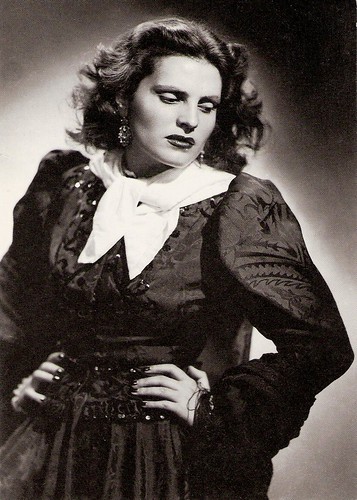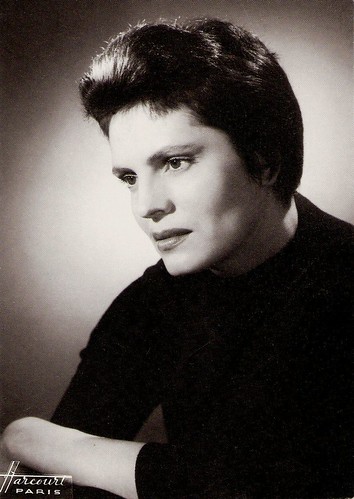
German postcard, no. 11.

French promotion card by Editions P.I., Paris, no. S-1053 - 35 K. Photo: Disques Ducretet Thompson.

French promotion card by Pathé Marconi, no. 1-69. Photo: Augusto Cabrita.
Breaking the Rules of Fado
Amália da Piedade Rebordão Rodrigues was born in Lisbon, Portugal in 1920, to a poor and numerous family. She was the daughter of trumpet player and cobbler Albertino de Jesus Rodrigues and Lucinda da Piedade Rebordão. Her sister was the Fado singer Celeste Rodrigues.
Since her childhood, Amália showed a talent for singing. At 19, she made her professional stage debut in 'Retiro da Severa' (Severe Retreat) in 1939. Frederico Valério, a classically-trained composer recognised the potential in her voice and wrote expansive melodies custom-designed for Rodrigues’ voice, breaking the rules of Fado by adding orchestral accompaniment. One of these composed fados was 'Fado do Ciúme' (Fado of Jealousy).
During World War II she carried out long tours through Spain and Brazil. In 1945 Rodrigues had her first great musical success with the song 'Ai Mouraria'. Two years later she debuted as an actress in the Portuguese film Capas Negras/Black Covers (Armando de Miranda, 1947) with Alberto Ribeiro. In Portugal, the film was heralded as the best film of the year. It helped to make Amália the most admired and beloved star of Portugal and an international celebrity.
The next years she appeared in Fado, História d'uma Cantadeira/Fado, History of a Singer (Perdigão Queiroga, 1948) and Vendaval Maravilhoso/Wonderful Gale (José Leitão de Barros, 1949).
In 1949 she sang for the first time in Paris and London. And in 1952 followed her debut in New York in 'La Vie en Rose'. Among her well-known songs are: 'Uma Casa Portuguesa' (A Portuguese House), 'Lisboa Antiga' (Old Lisbon), 'Foi Deus' (It was God), 'Coimbra' (also known as 'April in Portugal'), and many others.
In the early 1950s, the patronage of acclaimed Portuguese poet David Mourão-Ferreira marked the beginning of a new phase: Rodrigues sang many of the country's greatest poets, and some wrote lyrics specifically for her.

Portuguese postcard by the Museu Nacional do Teatro. Photo: Silva Nogueira, Lisbon (1946).

Portuguese postcard by the Museu Nacional do Teatro. Photo: Studio Harcourt (1956).

French postcard by Editions du Globe, Paris, no. 793. Photo: Harcourt, Paris.
The Lovers of Lisbon
Amália Rodrigues' performances and choice of repertoire pushed the boundaries of the Fado. She helped to redefine the Fado and to reconfigure it for her and subsequent generations. In effect, she wrote the rulebook on what Fado could be and on how a Fadista (female singer) should perform it.
In 1959 the American magazine Variety chose her as 'one of the four best female singers in history'. During this period she made some very successful films including the French production Les amants du Tage/The Lovers of Lisbon (Henri Verneuil, 1955) with Françoise Arnoul, the drama Sangue Toureiro/Bullfighter Blood (Augusto Fraga, 1958) - the first Portuguese film in colour, and As Ilhas Encantadas/Enchanted Isles (Carlos Vilardebó, 1965) with Pierre Clémenti.
Her 1968 single 'Vou Dar de Beber à Dor' (I'll Drink on the Pain) broke all sales records and her 1970 album 'Com que Voz' (With which voice) won a number of international awards. Over the years, she performed nearly all over the world — going as far as the Soviet Union and Israel.
When the Revolução Dos Cravos (Carnation's Revolution) happened on 25 April 1974 which finished 48 years of the Fascist government in Portugal, rumours arose that Amália Rodrigues collaborated with the deposed government. Juan Carlos Brazao writes in his bio of her at IMDb: "Her reputation was seriously affected (in fact, during the Salazar years, Rodrigues had been an occasional financial supporter of some communists in need).
She decided to retire from show business but only one year later, she performed again in the Coliseu Theater of Lisbon where 5,000 people gave her a standing ovation." Her return to the recording studio in 1977 with 'Cantigas numa Língua Antiga' (Songs in an old language) was received as a triumph. After that, Amália continued her career as if nothing happened.
In 1980 she debuted as a composer. In 1985, Rodrigues presented her first solo concert after 10 years in the Coliseu dos Recreios of Lisbon. The show broke all attendance records in Portugal. In 1989, President Mário Soares honored her for her artistic career of 50 years, and Pope John Paul II received her in a private audience in Rome, Italy.
During her last years, Amália received countless tributes. She was awarded one of Spain's highest honors, the Orden de Isabel, la Catolica (Laço de Dama) in 1968, and also was awarded France's highest honors: Chevalier de l'Ordre des Arts et des Lettres in 1970 and Commandeur de l'Ordre des Arts et des Lettres in 1985. Despite a series of illnesses involving her voice, Rodrigues continued recording as late as 1990.

German postcard by ISV, Sort. 17/6. Is this Amalia Rodrigues, the singer? Our friend Marlène Pilaete shared her doubts: "I’ve noticed that on IMDb, there is one Amalia Rodrigues (who is the famous Portuguese singer) and one Amalia Rodriguez who was mostly active in Spanish movies at the end of the fifties and in the sixties. IMDb gives her the same birth and death dates as those of the great Amalia Rodrigues but it is obviously a mistake. Could this Spanish lady be the lascivious doll on the German ISV postcard?"
Amália Rodrigues sings Canção Do Mar (Song of the Sea). Source: Alessandro Latimore (YouTube).
The Art of Amália
Amália Rodrigues eventually retreated from public performance, although her career gained in stature with an official biography by historian and journalist Vítor Pavão dos Santos, and a five-hour TV series documenting her fifty-year career featuring rare archival footage.
The series was later distilled into the 90-minute film documentary, The Art of Amália. Its director, Bruno de Almeida, has also produced Amália, Live in New York City, a concert film of her 1990 performance at New York City Town Hall. She made her last film appearance in Bis ans Ende der Welt/Until the End of the World (Wim Wenders, 1991).
In 1999, Amália Rodrigues suddenly died in her sleep at home in Lisbon. She was buried at an impressive funeral ceremony with the massive attendance of her fans.
Rodrigues had been married twice. First to lathe worker Francisco Da Cruz. The couple married in 1940 (according to Wikipedia; IMDb gives 1942) in Rio de Janeiro, Brazil, and divorced in 1946 (according to Wikipedia; IMDb gives 1944). In 1961 she married Brazilian engineer César Seabra, with whom she stayed together till his death in 1997. She had no children.
In 2001, Amália was awarded posthumously, with the Ordem do Infante D. Henrique (Grã Cruz) by President Jorge Sampaio. Her house in Rua de São Bento in Lisbon is now a museum.

National Pantheon, Igreja de Santa Engracia (The Santa Engracia Church), Lisbon, Portugal. Photo: Ivo Blom.
Amália Rodrigues sings 'Zanguei-me com o meu amor' in Fado, História d'uma Cantadeira (Perdigão Queiroga, 1948). Source: Verdegaio (DailyMotion).
Amalia Rodrigues sings 'Lisboa Antiga' in Casino Knokke, Belgium (1973). Source: Musiclover4 (DailyMotion).
Sources: Juan Carlos Brazao (IMDb), Wikipedia, and IMDb.
This post was last updated on 18 June 2021.
No comments:
Post a Comment